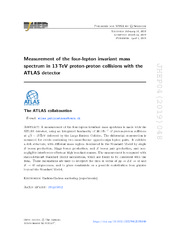Measurement of the four-lepton invariant mass spectrum in 13 TeV proton-proton collisions with the ATLAS detector
Aaboud, Morad; Aad, Georges; Abbott, Brad; Abdinov, Ovsat Bahram oglu; Abeloos, Baptiste; Abhayasinghe, Deshan Kavishka; Abidi, Syed Haider; AbouZeid, Hass; Abraham, Nadine L.; Abramowicz, Halina; Buanes, Trygve; Djuvsland, Julia Isabell; Eigen, Gerald; Fomin, Nikolai; Lipniacka, Anna; Martin dit Latour, Bertrand; Mæland, Steffen; Stugu, Bjarne; Yang, Zongchang; Zalieckas, Justas; Bugge, Magnar Kopangen; Cameron, David Gordon; Catmore, James Richard; Feigl, Simon; Franconi, Laura; Garonne, Vincent; Gramstad, Eirik; Hellesund, Simen; Morisbak, Vanja; Oppen, Henrik; Ould-Saada, Farid; Pedersen, Maiken; Read, Alexander Lincoln; Røhne, Ole Myren; Sandaker, Heidi; Serfon, Cédric; Stapnes, Steinar; Vadla, Knut Oddvar Høie; Abreu, Henso; Abulaiti, Yiming; Acharya, Bobby S.; Adachi, Shunsuke; Adam, Lennart; Adelman, Jareed; Adersberger, Michael; Adigüzel, Aytül; Adye, Tim; Affolder, Anthony Allen; Afik, Yoav; Agheorghiesei, Catalin; ATLAS, Collaboration
Peer reviewed, Journal article
Published version

Åpne
Permanent lenke
https://hdl.handle.net/1956/22806Utgivelsesdato
2019-04-05Metadata
Vis full innførselSamlinger
Originalversjon
https://doi.org/10.1007/jhep04(2019)048Sammendrag
A measurement of the four-lepton invariant mass spectrum is made with the ATLAS detector, using an integrated luminosity of 36.1 fb−1 of proton-proton collisions at s√ = 13 TeV delivered by the Large Hadron Collider. The differential cross-section is measured for events containing two same-flavour opposite-sign lepton pairs. It exhibits a rich structure, with different mass regions dominated in the Standard Model by single Z boson production, Higgs boson production, and Z boson pair production, and non-negligible interference effects at high invariant masses. The measurement is compared with state-of-the-art Standard Model calculations, which are found to be consistent with the data. These calculations are used to interpret the data in terms of gg → ZZ → 4ℓ and Z → 4ℓ subprocesses, and to place constraints on a possible contribution from physics beyond the Standard Model.
